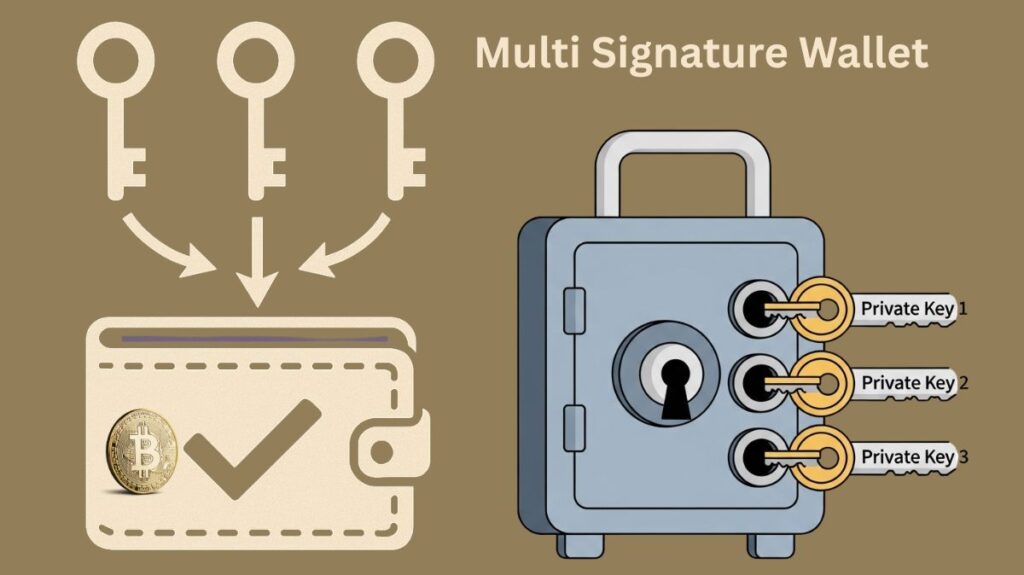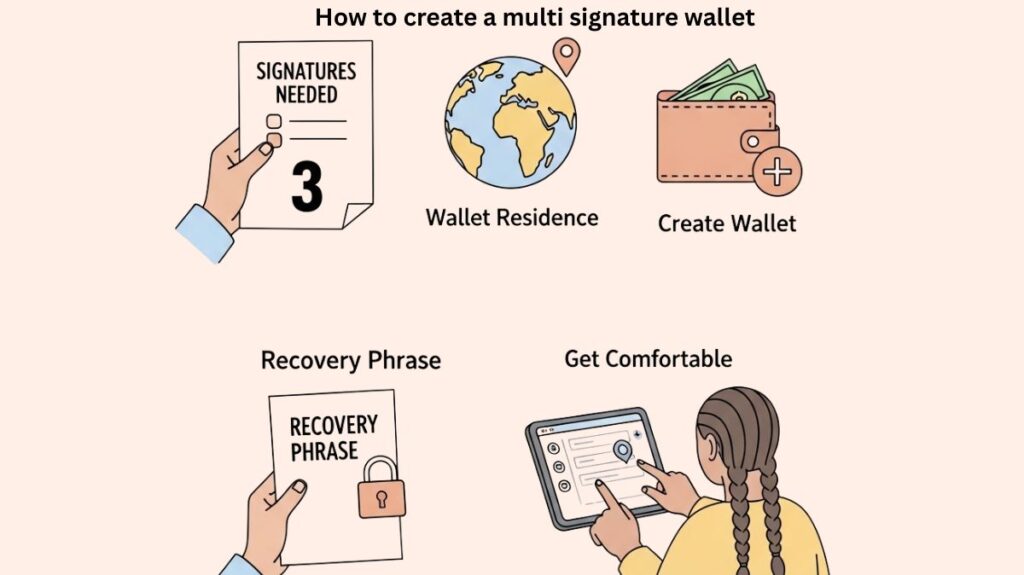This article covers a number of topics, including what is multi-signature wallet, how multi-signature wallets work, their goals and benefits, risks and drawbacks, common use cases, and how to create a multi signature wallet bitcion.
Multi signature wallet bitcoin

Often shortened to “multi-sig,” a multi-signature wallet is a kind of cryptocurrency wallet that needs two or more digital signatures in order to approve an outgoing transaction. Compared to conventional single-signature wallets, which only need one private key to access funds and sign transactions, this offers an extra degree of security.
Also Read About Multi Sig Meaning: Its Benefits And Enhanced Crypto Security
How Multi-Signature Wallets Work?
It’s useful to first comprehend how a single-signature transaction operates in order to comprehend multi-sig wallets. A single private key is used to sign and confirm that the user has sufficient cryptocurrency and has given permission for the transfer when a transaction is started on a blockchain in a conventional arrangement.
Distributed authorisation and shared control are the foundations of multi-sig wallets. Before every transaction can be completed, they require a certain quantity of authorized signatures. The procedure is broken down as follows:
Keys, both public and private
Each user of a cryptocurrency has a private key for signing transactions and a public key for accepting cash. In order to sign a transaction, multi-sig wallets need a specific quantity of private keys from a group and create a multi-sig address.
Configuration M-of-N
The standard notation for multi-sig wallets is “M-of-N,” where “M” represents the minimum number of necessary signatures and “N” represents the total number of potential signers. A “2-of-3” multi-sig wallet, for instance, requires that at least two of the three potential key holders sign the transaction in order for it to be considered legitimate. The phrases “2-of-2,” “3-of-3,” and “3-of-5” are other frequently used versions.
Procedure for Transactions
A transaction is broadcast to the network when it is started from a multi-sig wallet. Every authorised signer generates a cryptographic signature using their private key. After combining these signatures, the transaction is approved, validated by network nodes, and added to the blockchain when the necessary quantity of signatures is obtained.
This system makes sure that no one person may transfer money on their own. Through the use of a smart contract, the wallet’s programming divides authority across several users, requiring each user to authorise every transaction. These several signatures are combined into one by the blockchain’s code.
Multi-Signature Wallets’ goals and benefits
The purpose of multi-sig wallets is to reduce the likelihood that digital assets can be taken using just a wallet key or password. Enhanced security and distributed control over digital assets are their main objectives.
Increased Security
Even in the event that one private key is compromised, multi-sig wallets greatly reduce the likelihood that hackers or other bad actors would have unauthorized access to assets by removing single points of failure. To ensure that no one person can act alone, it’s comparable to having two military personnel to turn keys simultaneously in order to activate a weapon.
Governance and Internal Controls
Multi-sig wallets give organisations or groups the capacity to implement multi-approval procedures, which improves accountability and lowers the possibility of fraud, error, or single-person fund misuse. A majority’s decisions can be carried out.
Mitigation of Key Losses
As long as the necessary signature threshold can still be reached with the other private keys, money is safe and available even if one is lost. This gives you a fallback choice.
Openness
Trustless transactions are made possible by multi-sig wallets, which also encourage accountability by enabling community members to monitor wallet activity on block explorers and see who has transferred assets.
Adherence to Regulations
Multi-sig structures can enhance asset security and facilitate the segregation of duties, two important aspects of many regulatory systems.
Also Read About What Is Web3.js? The JavaScript Library For Blockchain DApps
Risks and drawbacks
Multi-sig wallets have a few disadvantages despite their benefits:
Complexity of Technology
More technical know-how is frequently needed to set up and maintain multi-sig wallets than regular wallets, particularly if you are not depending on outside suppliers.
Arrangement and Exchange
Velocity Transactions can take longer since they need the consent and signatures of several parties. They are therefore less suitable for groups or organisations that require regular or rapid transactions.
Challenges in Fund Recovery
Since several recovery phrases must be imported from several devices, recovering funds might be difficult if several key holders lose access or stop responding. Access to cash could be permanently lost if enough keys are misplaced or handled improperly.
Third Party Dependency
A single point of failure may be introduced if third-party services are used for setup, even if some multi-sig wallets can be self-custodial.
Legal Action
There is no one legal custodian of funds transferred into a shared wallet, making it challenging to pursue legal remedies if something goes wrong because blockchain and multi-sig addresses are still relatively new.
Malevolent Intention
All cryptocurrency wallets, including multi-sig ones, are susceptible to hacking and alteration since they are programs that may be maliciously coded.
Common Use Cases
When cryptocurrencies or other digital assets are held in custody by a firm or controlled by numerous people, multi-sig wallets come in handy. They may not be necessary for the majority of people, but they are appropriate in a number of situations:
- Companies and Group-Owned Property Multi-sig wallets can be used by businesses, particularly those that handle substantial sums of bitcoin, to guarantee that several executives or board members must concur on financial choices. This protects money from internal threats or from one individual taking all of the assets.
- Cooperative Accounts To guarantee agreement on transactions, those who hold assets jointly with a spouse or friend can use multi-sig.
- Autonomous Decentralized Organisations (DAOs) Web3 communities and DAOs use multi-sig wallets to manage shared treasuries and cash, limiting unilateral fund transfers and requiring stakeholder consensus for transactions.
- Escrow Deals Escrow, which involves a buyer, seller, and a third party who is mutually trusted, can be facilitated by a “2-of-3” multi-sig configuration. When requirements are fulfilled, funds are disbursed, and the arbitrator has the authority to mediate conflicts.
- Authentication using two factors (2FA) By keeping keys on many devices, a person can utilise a multi-sig wallet (such as 2-of-2 or 2-of-3) that requires access to multiple devices in order to authorise a transaction. Like conventional 2FA, this adds an additional layer of authentication.
- Custodial Exchanges and Services Multi-sig technology is used by companies that provide custodial solutions or cryptocurrency exchanges to enforce division of tasks and protect customer holdings and reserves from internal and external threats.
- Lightning Network for Bitcoin Opening payment channels in the Bitcoin Lightning Network requires multi-sig transactions, in which each party owns one of the necessary keys and locks bitcoins into a multi-sig wallet.
Also Read About Explain Digital Signature Algorithm Definition, Advantages
How to create a multi signature wallet

Create a multi-sig wallet in a few steps:
- Step 1:Determine how many signatures are needed to authorise transactions.
- Step 2: Decide on each wallet’s residence.
- Step 3: Create your wallet.
- Step 4: Protect your recovery phrases.
- Step 5: Get comfortable with the wallet.
There is a list of several multi-signature wallets, including Guarda, Arbitrum, and Electrum. Additionally, multi-sig wallets for Ethereum-compatible chains (Safe/Gnosis Safe) and Bitcoin (Unchained) can be created using Ledger devices.
